Bidding Zone Review
Downloads of the Bidding Zone Review (BZR) Study for the target year 2025
Key findings of the Bidding Zone Review for the year 2025:
According to the BZR methodology defined by ACER, TSOs were requested to assess 14 alternative configurations on the basis of 22 criteria grouped into four categories (network security, market efficiency, stability and robustness of BZs, and the energy transition). According to this methodology, the BZ configurations were ranked using the “economic efficiency” criterion.
The results of the economic efficiency criterion of alternative BZs are the following:
- For the Nordic Region: None of the studied alternative BZ configurations provide a higher economic efficiency. The result shows a negative change in economic efficiency for the configurations ranging from €2 million to €35 million compared to the status quo.
- For the Central Europe Region:
- The simulation results show a higher economic efficiency for all German–Luxembourgish split configurations (ranging from €251 million to €339 million for the 2025 target year), where the split of Germany–Luxembourg into five BZs performs the highest among the analysed alternative configurations in terms of economic efficiency.
- The Dutch split configuration also shows a slight positive effect on economic efficiency (€9 million for the 2025 target year).
- The French and Italian alternative configurations show a negative effect in economic efficiency.
The report includes two proposals of the TSOs (one from Central Europe TSOs and one from Nordic TSOs) on the future configuration of bidding zones in Europe.
The Nordic TSOs propose to maintain the current BZ configuration in Sweden as the report result shows a negative monetised benefit for all analysed Nordic configurations compared to the status quo.
For the TSOs of the Central Europe region, the simulation results indicate that the configuration with the highest positive monetised benefit in relation to criterion four (economic efficiency) compared to the status quo would be the split of Germany–Luxembourg into five BZs. The Central Europe TSOs proposal stresses that this result stems from the BZR methodology defined by ACER and does not take important additional aspects into account and therefore should not be seen in isolation, but rather in combination with certain considerations, which should be thoroughly assessed prior to the eventual decision of the relevant member state(s) affected by a split on the future BZ configuration, as they could have a considerable impact on the interpretation and the outcomes of the BZ Study performed by the TSOs.
The full study is available on ENTSO-E’s website
You can submit questions on the Bidding Zone study until 28 May using the following link: https://forms.office.com/e/vFhnP2ggMB
What is Bidding Zone Review (BZR)?
According to Commission Regulation (EU) 2015/1222 (CACM), bidding zones (BZs) should be defined in such a manner as to ensure efficient congestion management and overall market efficiency. In addition, according to the Commission Regulation (EU) 2019/943 (Electricity Regulation under the Clean Energy Package), bidding zone borders (BZBs) shall be based on long-term, structural congestions in the transmission network. BZs shall not contain such structural congestions unless they have no impact on neighbouring BZs, or unless as a temporary exemption, their impact on neighbouring BZs is mitigated with remedial actions and those structural congestions do not lead to reductions in cross-zonal trading capacity in accordance with the requirements of Article 16 of the Electricity Regulation.
Following the implementation of Commission Regulation (EU) 2019/943 (Electricity Regulation under the Clean Energy Package), all TSOs have to conduct a common study on alternative BZ configurations: the so-called bidding zone review (BZR),with the purpose to increase economic efficiency and cross-zonal trading, while maintaining security of supply in the EU.
History of this BZR Process
Article 14 of the Electricity Regulation triggers the BZR process; however, the actions prior to and after the review are outlined below:
Action 1 - TSOs’ proposal for the methodology, assumptions and alternative BZ configurations: all TSOs submitted a proposal concerning the methodology and assumptions to be applied in the BZR process and for alternative bidding zone configurations to be assessed by the relevant National Regulatory Authorities (NRAs) for approval, pursuant to Article 14(5) of Regulation (EU) 2019/943.
Action 2 - NRAs’ decision: on 17 December 2019, all NRAs informed all TSOs by letter that they considered the initial TSOs’ proposal incomplete due to the absence of alternative configurations in some bidding zone review regions and requested all TSOs to complete the proposal with proper alternative bidding zone configurations within two months.
On 18 February 2020, all TSOs resubmitted the updated proposal: The changes to the methodology include an amended wording related to the years of the scenarios to be used for the Bidding Zone Review. The updated proposal on bidding zone configurations contained the same alternative bidding zone configurations as initially submitted with the exception of the Nordic bidding zone review region which proposed an additional alternative configuration. The updated BZ package is available here.
Since the NRAs did not agree to approve the proposal, the decision on the methodology, assumptions, and alternative bidding zone configurations to be considered in the BZR process was transferred to the EU Agency for the Cooperation of Energy Regulators (ACER) on 13 July 2020.
Action 3 - ACER decision No 29/2020: On 24th November 2020, ACER issued its decision on the methodology and assumptions that are to be used in the BZR process and the alternative BZ configurations to be considered (hereafter: ACER Decision on the BZR Methodology). Additionally, Annex II of the ACER Decision on the BZR Methodology includes a request for TSOs to deliver the results of a European Locational Marginal Pricing (LMP) simulation pursuant to Article 11 of the methodology. The results are intended as input for ACER to define the alternative bidding zone configurations for the BZR process. In addition to Annex II, the BZR Methodology also contains annexes I, Ia, Ib and III
Action 4 - LMP simulation: TSOs of Continental Europe and Ireland as well as Nordic Bidding Zone Review Regions (BZRRs) performed the LMP study between 24 November 2020 and 4 March 2022. The results of the study are available in the ENTSO-E LMP Report, available on the ENTSO-E website here
Action 5 - ACER’s decision on alternative BZ configurations: The final ACER decision on the alternative BZ configurations was adopted on 8 August 2022.
Action 6 – BZR and BZ Study: the publication of the final ACER decision dating 8 August 2022, initiates the formal BZR process in which TSOs assess 14 alternative configurations for the 2025 target year on the basis of 22 criteria grouped into four categories (network security, market efficiency, stability and robustness of BZs, and energy transition). According to this methodology, the BZ configurations were ranked using the “economic efficiency” criterion (criterion 4).
Main deliverables of this BZR
The main deliverables of the BZR study are:
- a final report with an assessment of 22 indicators, and
- the participating TSOs’ joint proposals regarding the bidding zone configurations for each respective bidding zone review region (one from the TSOs of the bidding zones review region Central Europe and one from the TSOs of the bidding zones review region Nordic).
Decision on adoption of alternative BZ configuration: Following the 12-month BZR process under Article 14(8) of Electricity Regulation, those Member States that have opted to amend the BZ configuration, shall reach a unanimous decision to maintain or amend the BZs in 6 months. In the case the Member States cannot reach a unanimous decision, the European Commission, as the last resort, in consultation with ACER shall adopt a decision in 6 months.
Bidding Zone Review process in a nutshell
The Bidding Zone Review is performed as follows:
- at an all-TSO level, for the execution of pan-EU studies, general coordination, and stakeholder management, and
- at regional level, for performing modelling activities, performed by Bidding Zone Review Regions (BZRRs).
This setup is chosen to reduce model complexity and to be able to consider regional specificities and sensitivities, while involving all TSOs.
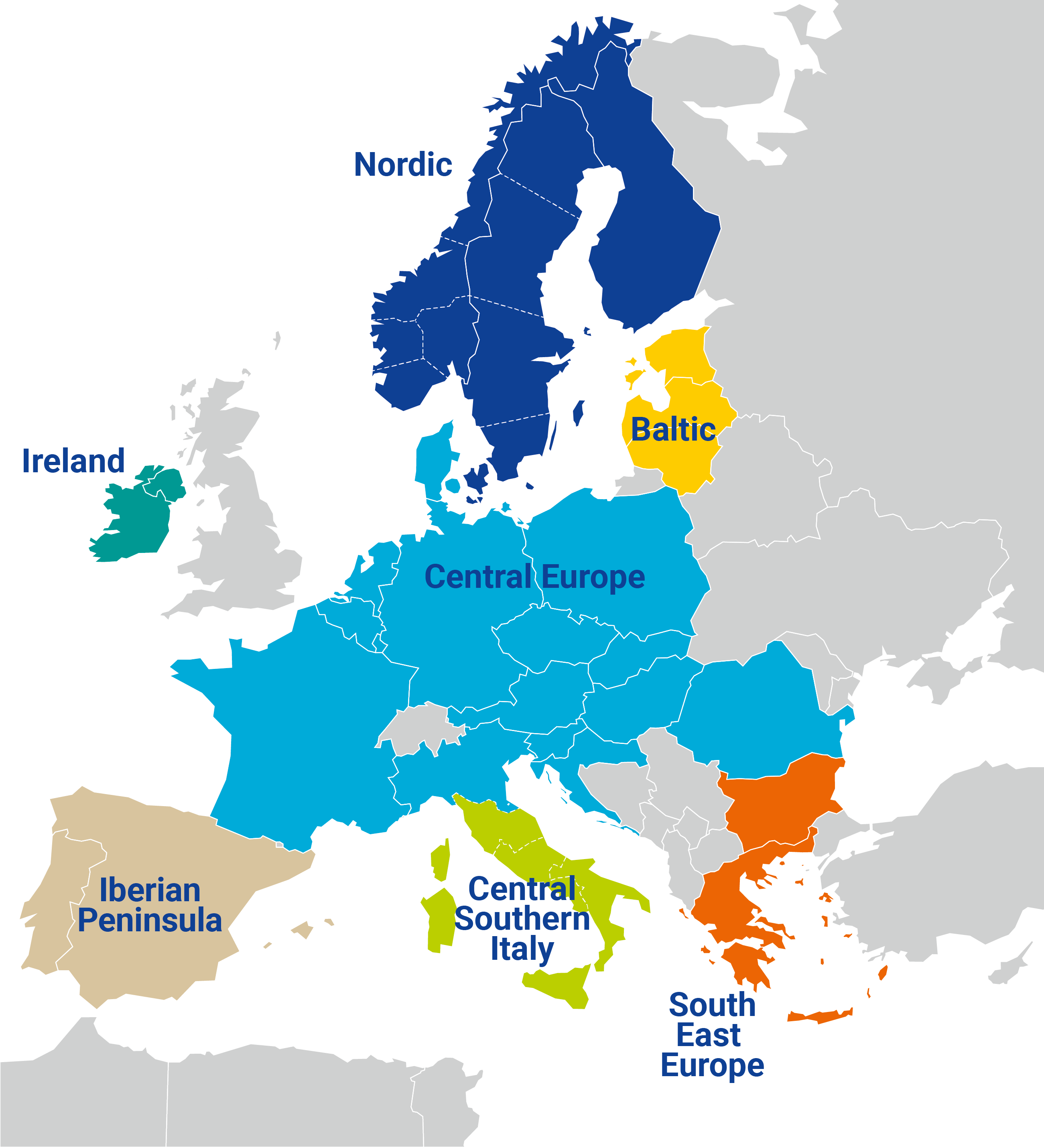
For affected BZRRs, several alternative BZ configurations are studied. The target year, which is to be investigated, is the year 2025.
In total, 22 indicators grouped into 4 categories have to be assessed in the BZR, as shown below:
Network security
- 1. Operational security
- 2. Security of supply
- 3. Uncertainty in cross-zonal capacity calculation
Market efficiency
- 4. Economic efficiency
- 5. Firmness costs
- 6. Market liquidity & transaction costs
- 7. Market concentration & market power
- 8. Effective competition
- 9. Price signals for building infrastructure
- 10. Accuracy & robustness of price signals
- 11. Transition costs
- 12. Infrastructure costs
- 13. Market outcomes in comparison to corrective measures
- 14. Adverse effects of internal transactions on other BZs
- 15. Impact on operation and efficiency of balancing
Stability & robustness of BZs
- 16. Stability & robustness of price signals over time
- 17. Consistency across capacity calculation time frames
- 18. Assignment of generation and load units to BZs
- 19. Location and frequency of congestion, market and grid
Energy transition
- 20. Short-term effects on carbon emissions
- 21. Short-term effects on RES integration
- 22. Long-term effects on low-carbon investments
Assessed alternative BZ configurations
ACER’s decision on alternative BZ configurations was issued on 8 August 2022, followed by a news item The following table summaries the proposal from ACER. Additional information can be found in Annex 1 of ACER’s decision.
Table: Alternative configurations to be considered for the bidding zone review:
| Identifier | BZRR | Number of BZs per MS | Source (ACER’s algorithm/TSOs) | Fallback configuration identifier | Configuration assessed in BZR (Yes/No) |
|---|---|---|---|---|---|
| 1 | CE | DE2 | k-means | 14 | No |
| 2 | CE | DE2 | Modified version of Spectral P1 following remarks provided by German TSOs | Yes | |
| 3 | CE | DE3 | Spectral P1 | 12 | No |
| 4 | CE | DE4 | Modified version of Spectral P1 following remarks provided by German TSOs | 13 | No |
| 5 | CE | FR3 | Spectral P1 | Yes | |
| 6 | CE | IT2 | k-means | Yes | |
| 7 | CE | NL2 | Spectral DIRC | Yes | |
| 8 | Nordic | SE3 | Spectral P1 | Yes | |
| 9 | Nordic | SE3 | Modified version of Spectral P1 following remarks provided by Svenska kraftnät | Yes | |
| 10 | Nordic | SE4 | Spectral P1 | Yes | |
| 11 | Nordic | SE4 | Modified version of Spectral P1 following remarks provided by Svenska kraftnät | Yes | |
| 12 | CE | DE3 | Modified version of configuration 3 to align with Amprion’s control area borders | Yes | |
| 13 | CE | DE4 | Modified version of configuration 4 to align with Amprion’s control area borders | Yes | |
| 14 | CE | DE5 | Modified version of configuration 13, including a new bidding zone in Schleswig-Holstein | Yes | |
| 15 onward | CE | Combinations as derived during the bidding zone review study |
According to Article 2 of Annex 1 of ACER’s decision, TSOs needed to replace the concerned configuration(s) with the corresponding fallback configurations if a unique and unambiguous assignment of nodes to zones could not be achieved. Following the ACER decision, a simplified assessment of the node-to-zone assignment was performed detecting issues for the default configurations 1, 3 and 4 due to the split through the densely-populated, highly-meshed Ruhr area (largest urban area in Germany with many cities, industrial sites and power plants and an extensively meshed 110 kV network). Therefore, TSOs followed the ACER decision and evaluated the German fallback configurations in the Bidding Zone Review. Specifically, this means that configurations with the IDs 2, 12, 13 and 14 were assessed in the Bidding Zone Review for Germany. Please note that this does not prevent potential issues to occur related to the node-to-zone assignment also for the fallback configurations. More background information on this topic can be found in the material for the Consultative Group Call of 14th December 2022.
BZR Data Publication
16 September 2022: LMP Data Items
According to Article 16 of the Bidding Zone Review (BZR) Methodology, TSOs shall publish all inputs for the BZR no later than four months after the BZR starts, and all outputs of the BZR no later than one month after the BZR ends. Moreover, Article 16 states the status of certain information as confidential under a given jurisdiction shall not prevent that information from being published in another jurisdiction. The BZR Methodology, and a later ACER decision, put an obligation on TSOs and ENTSO-E to publish data related to the Locational Marginal Pricing (LMP) study.
TSOs published the following data sets
- Network grid model used for LMP study*,
- PEMMDB, and
- LMP results, including nodal granularity, flows in network, constraints and shadow prices, cleared generation/storage.
Interested stakeholders can access the data sets as follows:
- Request the dataset
- Flows in Network
- Cleared Demand
- Cleared Generation
- Cleared Storage
- Constraints and Shadow Prices
- Socio-Economic Welfare
- Input Files
- Nodal Prices
Svenska kraftnät (Svk) coordinates were published in list and Geographic Information System (GIF) format:
- Coordinates in list format
- Coordinates in GIF format:
- Coordinates published on SVK’s website
Disclaimers:
- The information provided in the data sets shall not in any circumstances be interpreted as a price forecast by TSOs. The results should be solely understood as a simulation result of the LMP study according to the BZR Methodology and serve only for the purposes of BZR study.
- *The Nordic grid data (CGM and CNECs) is confidential and has a high protection value, therefore it cannot be published and shared due to security regulations in Sweden and Norway. As in the Nordics there is a common grid model, the grid data can only be published in its entirety.
8 December 2022: Input Data to BZR
Following the legal obligations set in Article 16 of the Bidding Zone Review (BZR) Methodology, TSOs published inputs for the BZR on 8 December 2022. Article 16 states the status of certain information as confidential under a given jurisdiction shall not prevent that information from being published in another jurisdiction.
TSOs are publishing the following input data:
- CE BZRR: Input Data and Assumptions Overview
- CE BZRR: Annex A – Input Data and Assumptions Overview
- Nordic BZRR: Input Data and Assumptions Overview
- Nordic BZRR: Annex A – Input Data and Assumptions Overview
Disclaimer: Data input files published here may be subject to change at a later stage, due to possible feedback from ACER and NRAs on input data submitted in accordance with the legal obligations.
As foreseen in article 17 (3) of the BZR Methodology, ACER and NRAs provided comments on the input data that were duly considered by the TSOs. The following document provides an overview of all comments received and how they have been taken into account:
- ACER and NRAs’ feedback note;
- TSOs’ formal response to ACER and NRAs’ feedback note
28 April 2025: Published Report and Annexes
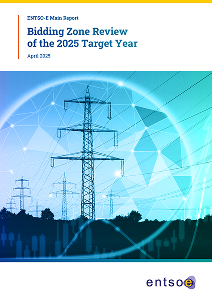
Bidding Zone Review of the 2025 Target Year
Read the BZR 2025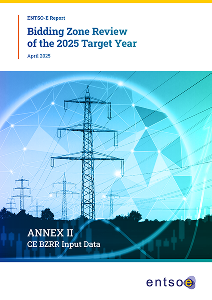
Annex 2 CE BZRR Input Data
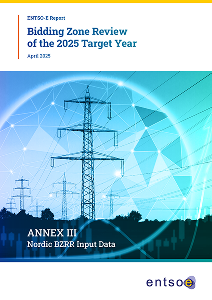
Annex 3 Nordic BZRR Input Data
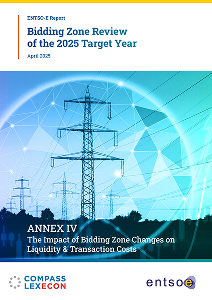
Annex 4 Study on the Impact of Bidding Zone Changes on Liquidity and Transaction Costs
Read the Annex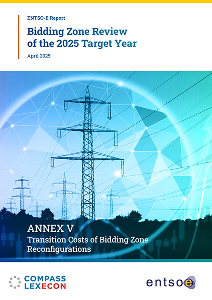
Annex 5 Study on Transition Costs of Bidding Zone Reconfiguration
Read the Annex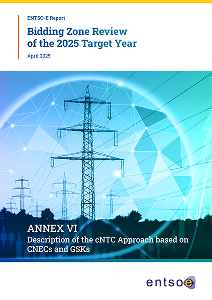
Annex 6 CE Additional Explanation on the cNTC Approach for BZRR (CE)
Read the Annex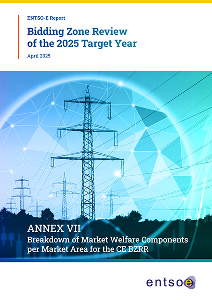
Annex 7 Breakdown of Market Welfare Components per Market Area for the CE BZRR
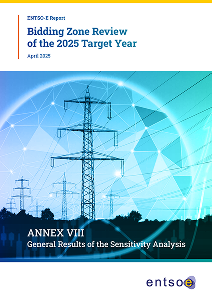
Annex 8 General Results of the Sensitivity Analysis in the CE BZRR
Read the Annex28 May 2025: Output Data from BZR
Following the legal obligations set in Article 16 of the Bidding Zone Review (BZR) Methodology, TSOs published the output data from the BZR one month after the publication of the BZ Study, i.e., by 28 May 2025. TSOs are publishing the following input data:
- CE BZRR: Output Data Description
- CE BZRR: Output Data (ZIP Folder)
- Nordic BZRR: Output Data Description
- Nordic BZRR: Output Data (ZIP Folder)
Stakeholder interaction
Stakeholder expertise is essential for any discussion of a fundamental market design element such as the BZ configurations. ENTSO-E and the TSOs have striven to involve a wide range of stakeholders from the start of the BZR process, with substantial consultation during the review; this included the Bidding Zone Review Consultative Group (BZR CG), Market European Stakeholder Committee (MESC) as well as public workshops and consultations.
Bidding Zone Review Consultative Group
ENTSO-E, on behalf of all TSOs, created the BZR CG to serve as a platform for relevant stakeholders to interact with ENTSO-E and its members on achieving the objectives of the BZR. The BZR CG does not replace the obligation to organise a public consultation on the BZR but is merely an addition to facilitate additional exchanges with relevant stakeholders.
The BZR CG is composed of representatives from 17 stakeholders, including: European market parties’ associations, national market parties’ associations from BZs of active BZRRs, as well as European research institutes and think-tanks.
- Association of European Energy Exchanges (EUROPEX)
- Eeuropean Federation of Energy Traders (EFET)
- Energie-Nederland
- Energiföretagen Sverige
- EnergyVille (represented by KU Leuven)
- Fraunhofer Institute for Applied Information (Fraunhofer FIT)
- German Association of Energy and Water Industries (BDEW)
- International Federation of Industrial Energy Consumers
- Nord Pool Power Exchange, Sweden
- Norsk Hydro
- Swedish NRA (observer in BZR CG)
- Technical University of Munich
- Union of the Electricity Industry (EUROLECTRIC)
- Univeristé Libre de Bruxelles
- University of Bayreuth
The BZR CG was created on the basis of Terms of Reference drafted by ENTSO-E and the TSOs.
Market European Stakeholder Committee
The European Stakeholder Committees (ESCs) were established to inform and consult stakeholders on the implementation of the European network codes and guidelines. There are three different ESCs, each covering a family of network codes. The Market European Stakeholder Committee (MESC) is chaired by ACER, co-organised by ENTSO-E and the EC is an observer. The MESC participants are the key stakeholders involved in the implementation of European market network codes and guidelines.
ENTSO-E and the TSOs continue to provide regular updates to the MESC participants as the BZR process continues.
More information on MESC can be found here
Public Workshops
ENTSO-E and the TSOs will be organising regular public workshops with a wide range of stakeholders to provide update on the BZR process.
- 6 May 2025, from 09:00 to 12:00 - ENTSO-E Town Hall Meeting on the BZ Study.
- 6 May 2025: Svenska kraftnät (Svk) Public Webinar on the outcome of the BZ Study (focus on Nordic BZRR)
- 28 April 2025: TSOs publish the final report on the BZ Study for the year 2025
- 14 November 2022: Svenska kraftnät (Svk) webinar on BZR
- 16 September 2022: ENTSO-E Bidding Zone Review Workshop on Transition Costs Questionnaire and Status Update
- 21 April 2022: ENTSO-E Bidding Zone Review Stakeholders’ Workshop
Public Consultations
The public consultation took place between 19 July – 4 September 2024 and addressed the following aspects:
- The impacts of alternative BZ configurations on the following criteria: ‘Market liquidity and transaction costs’ and ‘Transition costs’ based on the reports on both criteria that will be provided with the public consultation material;
- Possible measures to mitigate negative impacts of specific alternative BZ configurations regarding the reports on ‘Market liquidity and transaction costs’ and ‘Transition costs’ criteria; and
- The identification of practical considerations which may need to be considered in case of a possible BZ configuration change as set forth in Article 14(10) of the Electricity Regulation, including possible timescales for implementation of alternative BZ configurations.
The link to the public consultation is available here. The questionnaire for the public consultation in pdf format is available here.
Events
To make the information accessible and transparent for stakeholders, key information such as presentation materials, recordings, stakeholder questions & feedbacks is published on this webpage.
Latest developments:
- 28 April 2025: TSOs publish the final report on the BZ Study for the year 2025
- 20 August 2024: Public webinar on the BZR public consultation
19 July 2024: launch of the joint public consultation for both, CE and Nordic BZRRs
19 July 2024: TSOs publish the Liquidity and Transaction Costs study report (i.e., version for the Public Consultation)
1 February 2024: TSOs publish the Transition Costs study report (i.e., version for the Public Consultation)
Disclaimer: Comments on this document can only be made during the public consultation.30 November 2023: TSOs’ formal response to ACER and NRAs’ feedback note on scenarios, sensitivities and input data used for the BZR study
3 May 2023: ACER and NRAs’ feedback note on scenarios, sensitivities and input data used for the BZR study
3 October 2022: Svk publishes coordinates and maps of alternative BZ configurations
16 September 2022: ENTSO-E invites stakeholders to fill in Questionnaire on Transition Costs study
- 8 August 2022: ACER’s decision on alternative BZ configurations
- 4 March 2022: TSOs submit results of LMP simulation to ACER
- 24 November 2020: ACER Decision on the BZR Methodology
13 July 2020: Decision on the BZR Methodology transferred to ACER
- 18 February 2020: BZR methodology, assumptions, and configurations – TSOs proposal resubmitted to NRAs
- 17 December 2019: NRAs communicate a letter to the TSOs on the initial TSOs’ proposal:
- NRAs informed TSOs the proposal is incomplete due to the absence of alternative configurations in some bidding zone review regions and requested all TSOs to complete the proposal with proper alternative bidding zone configurations within two months.
- 1 October 2019: All TSOs’ proposal for the methodology and assumptions that are to be used in the BZR process and for the alternative BZ configurations
Meetings
- 5 November 2024: BZR CG Online Meeting
- Slides
- Minutes of the meeting will be shortly available online
- 11 July 2024: BZR CG Online Meeting
- News item
- Slides: on pan-EU studies; on overall BZR study
- Minutes of the meeting will be shortly available online
- 5 December 2023: BZR CG Online Meeting
- 4 July 2023: BZR CG Online Meeting
- 3 March 2023: BZR CG Online Meeting
- 14 December 2022: BZR CG Online Meeting
- 13 October 2022: BZR CG Physical Meeting
- 1 September 2022: BZR CG Online Meeting
- 5 July 2022: BZR CG Kick-Off Meeting
 ENTSO-E
ENTSO-E